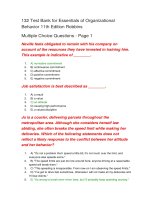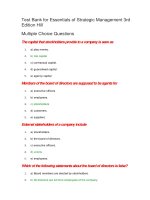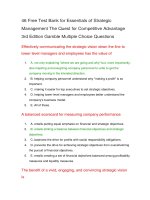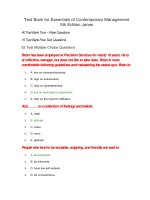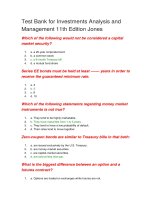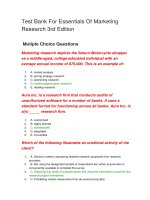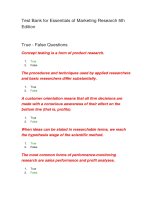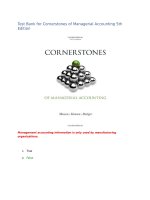108 test bank for essentials of contemporary management 5th edition jones
Bạn đang xem bản rút gọn của tài liệu. Xem và tải ngay bản đầy đủ của tài liệu tại đây (143.8 KB, 29 trang )
Test Bank for Essentials of Contemporary Management
5th Edition Jones
40 Test Bank True – False Questions
15 Test Bank Free Text Questions
53 Test Multiple Choice Questions
Brian has been employed at Precision Services for nearly 10 years. He is
an effective manager, but does not like to take risks. Brian is more
comfortable following guidelines and maintaining the status quo. Brian is:
1.
A. low on conscientiousness.
2.
B. high on extraversion.
3.
C. high on agreeableness.
4.
D. low on openness to experience.
5.
E. high on the need for affiliation.
A(n) _____ is a collection of feelings and beliefs.
1.
A. habit
2.
B. attitude
3.
C. value
4.
D. norm
5.
E. aptitude
People who tend to be sociable, outgoing, and friendly are said to:
1.
A. be extraverts.
2.
B. be introverts.
3.
C. have low self-esteem.
4.
D. be conscientious.
5.
E. have an internal locus of control.
The rites of _____ determine how individuals enter, advance within, and
leave the organization.
1.
A. passage
2.
B. integration
3.
C. celebration
4.
D. inauguration
5.
E. enhancement
Max enjoys being the center of attraction during his office parties. He has
excellent social skills and easily makes friends with new employees. He
can rightly be said to:
1.
A. have an internal locus of control.
2.
B. be an extravert.
3.
C. have a low self-esteem.
4.
D. be an introvert.
5.
E. be conscientious.
An individual's enduring tendency to feel, think, and act in certain ways
are referred to as his/her:
1.
A. personality traits.
2.
B. terminal values.
3.
C. norms.
4.
D. attitudes.
5.
E. moods.
_____ is the tendency to be original, have broad interests, be daring, and
take risks.
1.
A. Agreeableness
2.
B. Conscientiousness
3.
C. Openness to experience
4.
D. Introversion
5.
E. Negative affectivity
Emotional intelligence can help managers perform interpersonal roles like
that of a:
1.
A. resource allocator.
2.
B. monitor.
3.
C. planner.
4.
D. liaison.
5.
E. decision maker.
Which of the following reflects the distinctive ways in which
organizational members perform their jobs and relate to others inside and
outside the organization?
1.
A. Organizational culture
2.
B. Organizational capital
3.
C. Organizational hierarchy
4.
D. Organizational planning
5.
E. Organizational structure
People who are less inclined toward social interactions and to have a less
positive outlook are known to be:
1.
A. optimistic.
2.
B. dominant.
3.
C. introverts.
4.
D. agreeable.
5.
E. extraverts.
Orbit Inc., puts out newspaper releases announcing employees'
promotions. This is an example of a rite of:
1.
A. inauguration.
2.
B. celebration.
3.
C. integration.
4.
D. passage.
5.
E. enhancement.
Whenever Cate does not perform well in a test, she blames it on the lack
of preparedness on her part. Cate is said to have:
1.
A. an external locus of control.
2.
B. low self-esteem.
3.
C. a low sense of achievement.
4.
D. high neuroticism.
5.
E. an internal locus of control.
Which of the following posits that when founders hire employees for their
new ventures, they tend to be drawn to and choose employees whose
personalities are similar to their own?
1.
A. Equity theory
2.
B. Attraction-selection-attrition framework
3.
C. Belief-desire-intentional framework
4.
D. Organizational commitment
5.
E. Socialization
Which of the following is true of the planning process in an organization
with an innovative culture?
1.
A. It encourages lower-level managers to participate in the process.
2.
B. It rarely takes risks involving the development of new products.
3.
C. It emphasizes formal top-down planning.
4.
D.It subjects the suggestions from lower-level managers to a formal review
process that significantly slows decision making.
5.
E. It creates a well-defined hierarchy of authority and establishes clear reporting
relationships so that employees know exactly whom to report to.
The extent to which an individual desires to influence others is known as
the individual's need for:
1.
A. affiliation.
2.
B. affection.
3.
C. power.
4.
D. conscientiousness.
5.
E. benevolence.
Organizational citizenship behaviors refer to an employee's:
1.
A. strict adherence to organizational goals.
2.
B. willingness to perform above and beyond the call of duty.
3.
C. indisposition to offer suggestions to the organization.
4.
D. emotional attachment to the organization.
5.
E. collection of feelings and beliefs about the organization as a whole.
An intense, relatively short-lived feeling is called a(n):
1.
A. emotion.
2.
B. value.
3.
C. motivation.
4.
D. commitment.
5.
E. attitude.
According to psychologist David McClelland, the extent to which an
individual has a strong desire to perform challenging tasks well and to
meet personal standards for excellence is known as the individual's need
for:
1.
A. affiliation.
2.
B. achievement.
3.
C. power.
4.
D. affection.
5.
E. conscientiousness.
What are the big five personality traits?
1.
A. Extraversion, tension, perfectionism, self-reliance, and apprehension
2.
B. Extraversion, negative affectivity, agreeableness, conscientiousness, and
openness to experience
3.
C. Extraversion, negative affectivity, agreeableness, conscientiousness, and
tension
4.
D. Extraversion, negative affectivity, agreeableness, tension, and perfectionism
5.
E. Extraversion, negative affectivity, tension, perfectionism, and self-reliance
The tendency to experience positive emotions and moods and feel good
about oneself and the rest of the world is known as:
1.
A. conscientiousness.
2.
B. openness to experience.
3.
C. rationality.
4.
D. extraversion.
5.
E. social recognition.
The need for _____ is the extent to which an individual is concerned about
establishing and maintaining good interpersonal relations, being liked,
and having the people around him/her get along with one another.
1.
A. power
2.
B. self-esteem
3.
C. conscientiousness
4.
D. achievement
5.
E. affiliation
Edward, a manager at Real Corp., is a very positive individual. He rarely
exhibits adverse emotions or moods and is always optimistic about
himself and others. It can be said that Edward is:
1.
A. low on negative affectivity.
2.
B. low on agreeableness.
3.
C. high on conscientiousness.
4.
D. high on self-esteem.
5.
E. an extravert.
The tendency of a person to feel bad emotions and moods, to feel
distressed, and to be critical of oneself and others is called:
1.
A. agreeableness.
2.
B. conscientiousness.
3.
C. negative affectivity.
4.
D. high on self-esteem.
5.
E. optimism.
People who believe that outside forces are responsible for what happens
to and around them and do not think that their own make much of a
difference have:
1.
A. a high sense of achievement.
2.
B. less neuroticism.
3.
C. an internal locus of control.
4.
D. an external locus of control.
5.
E. high self-esteem.
As a manager, Nancy is known in the company as a risk-taker and an
innovator. Nancy is:
1.
A. high on introversion.
2.
B. low on agreeableness.
3.
C. high on openness to experience.
4.
D. high on negative affectivity.
5.
E. high on conscientiousness.
Organizational _____ comprises the shared set of beliefs, expectations,
values, norms, and work routines that influence how members of an
organization relate to one another and work together to achieve
organizational goals.
1.
A. planning
2.
B. hierarchy
3.
C. chart
4.
D. structure
5.
E. culture
The collection of feelings and beliefs that managers have about their
current jobs is referred to as:
1.
A. organizational citizenship behavior.
2.
B. job satisfaction.
3.
C. organizational culture.
4.
D. organizational commitment.
5.
E. emotional intelligence.
The process by which newcomers learn an organization's values and
norms and acquire the work behaviors necessary to perform jobs
effectively is known as organizational:
1.
A. conscientiousness.
2.
B. socialization.
3.
C. planning.
4.
D. controlling.
5.
E. agreeableness.
Steven is an effective and efficient manager. However, he is quite
pessimistic and avoids social interactions. Steven can be classified as an:
1.
A. extravert.
2.
B. individual with a high external locus of control.
3.
C. individual with high self-esteem.
4.
D. introvert.
5.
E. individual who is open to change.
Which of the following is an example of a terminal value?
1.
A. Self-reliant
2.
B. Self-sufficient
3.
C. Self-respect
4.
D. Self-controlled
5.
E. Self-disciplined
With regard to the managerial function of leading in an organization with
an innovative culture, managers:
1.
A. emphasize formal top-down communication.
2.
B. emphasize caution, maintenance of the status quo, and set specific goals.
3.
4.
5.
C. are likely to lead by example, encouraging employees to take risks and
experiment.
D. are likely to use management by objectives.
E. constantly monitor subordinates' progress toward goals, overseeing their every
move.
Whenever Daniel performs well in a test, he thinks that his teacher was
being lenient or that he was lucky. Daniel is said to have:
1.
A. an internal locus of control.
2.
B. high self-esteem.
3.
C. a high sense of achievement.
4.
D. low neuroticism.
5.
E. an external locus of control.
In Dave's Steel Manufacturing Co., new employees go through a short
orientation process after their induction. During this process, they are told
about the organization and its history, values, jargon, culture, and
procedures. They are then introduced to their work group, the specific
people they would work with, informed about their own role in the
organization, the skills needed to do their job, and both formal procedures
and informal norms. This is an example of organizational:
1.
A. controlling.
2.
B. planning.
3.
C. socialization.
4.
D. agreeableness.
5.
E. conscientiousness.
Which of the following is true of the managerial function of organizing in
an organization that has a conservative culture?
1.
A.It has a decentralized authority which encourages employees to work together
to solve ongoing problems.
2.
B. It creates a well-defined hierarchy of authority and establishes clear reporting
relationships so that employees know exactly whom to report to.
3.
C. A product team structure is most suitable for an organization with a
conservative culture.
4.
D. Such organizations have a flat structure.
5.
E. Such organizations have fewer levels in the hierarchy.
As the night manager of Spicy Bites, Ronald feels competent, deserving,
and capable of handling most situations. Ronald:
1.
A. has an external locus of control.
2.
B. has low sense of achievement.
3.
C. has high self-esteem.
4.
D. is highly hedonistic.
5.
E. is highly self-critical.
_____ is the degree to which individuals feel good about themselves and
their capabilities.
1.
A. Self-esteem
2.
B. Attitude
3.
C. Emotional intelligence
4.
D. Self-criticism
5.
E. Hedonism
_____ signify what an organization and its employees are trying to
accomplish.
1.
A. Emotions
2.
B. Moods
3.
C. Terminal values
4.
D. Instrumental values
5.
E. Attitudes
A(n) _____ value is a personal conviction about desired modes of conduct
or ways of behaving.
1.
A. terminal
2.
B. personal
3.
C. social
4.
D. ends
5.
E. instrumental
The formal events that recognize incidents of importance to the
organization as a whole and to specific employees are known as:
1.
A. values.
2.
B. rituals.
3.
C. stories.
4.
D. rites.
5.
E. norms.
Which of the following refers to a feeling or state of mind?
1.
A. Affect
2.
B. Moods
3.
C. Values
4.
D. Emotional labor
5.
E. Self-efficacy
The tendency to get along well with others is known as:
1.
A. need for affiliation.
2.
B. agreeableness.
3.
C. conscientiousness.
4.
D. self-esteem.
5.
E. need for achievement.
Every year on the Saturday prior to Christmas, Smart Enterprises holds its
annual holiday party. This is an example of a rite of:
1.
A. enhancement.
2.
B. integration.
3.
C. inauguration.
4.
D. celebration.
5.
E. passage.
People who have _____ believe they themselves are responsible for their
own fate; they see their own actions and behaviors as being major and
decisive determinants of important outcomes.
1.
A. low self-esteem
2.
B. a low sense of achievement
3.
C. high neuroticism
4.
D. an internal locus of control
5.
E. an external locus of control
Penelope is a manager with Quick Pizza. She is very good at
understanding the feelings of her subordinates and takes time out for all
of them. She listens to their problems, sympathizes with them, and tries
her best to give them solutions regarding the same. From this information,
it can be said that Penelope is:
1.
A. an introvert.
2.
B. a pessimist.
3.
C. high on agreeableness.
4.
D. low on conscientiousness.
5.
E. high on ambition.
A(n) _____ value is a personal conviction about lifelong goals or
objectives.
1.
A. terminal
2.
B. instrumental
3.
C. moral
4.
D. means
5.
E. competence-related
Which of the following describes what managers are trying to achieve
through work and how they think they should behave?
1.
A. Emotions
2.
B. Moods
3.
C. Intelligence
4.
D. Values
5.
E. Attitudes
_____ is the tendency to be careful, scrupulous, and persevering.
1.
A. Conscientiousness
2.
B. Openness to experience
3.
C. Need for achievement
4.
D. Agreeableness
5.
E. Extraversion
The collection of feelings and beliefs that managers have about their
organization as a whole is known as organizational:
1.
A. commitment.
2.
B. climate.
3.
C. citizenship.
4.
D. socialization.
5.
E. culture.
_____ guide how the organization and its members achieve organizational
goals.
1.
A. Attitudes
2.
B. Emotions
3.
C. Moods
4.
D. Instrumental values
5.
E. Terminal values
Unwritten, informal codes of conduct that prescribe how people should
act in particular situations and are considered important by most
members of a group are known as:
1.
A. norms.
2.
B. goals.
3.
C. values.
4.
D. ideologies.
5.
E. rules.
Managers who are _____ appear to lack direction and self-discipline.
1.
A. low on negative affectivity
2.
B. low on conscientiousness
3.
C. low on agreeableness
4.
D. extraverts
5.
E. optimists
With regard to the managerial function of controlling in an organization
that has a conservative culture, managers:
1.
A.recognize that there are multiple potential paths to success and that failure must
be accepted for creativity to thrive.
2.
B. are less concerned about employees' performing their jobs in a specific,
predetermined manner.
3.
C.are concerned about employees' being flexible and taking the initiative to come
up with ideas for improving performance.
4.
D. set specific, difficult goals for employees, frequently monitor progress toward
these goals, and develop a clear set of rules that employees are expected to
adhere to.
5.
E. encourage risk taking, creativity, and innovation.
One of the attributes that make Anthony an excellent manager is his
ability to understand the moods of his subordinates coupled with his
ability to manage his own moods. Anthony has a high level of:
1.
A. fluid intelligence.
2.
B. intelligence quotient.
3.
C. emotional intelligence.
4.
D. crystallized intelligence.
5.
E. dispositional effect.
40 Free Test Bank for Essentials of Contemporary
Management 5th Edition Jones True - False Questions
People who are high on extraversion are especially likely to experience
positive moods.
1.
True
2.
False
Managers who are low on extraversion are not efficient even in jobs that
require very little social interaction.
1.
True
2.
False
The effectiveness of managers is determined by a complex interaction
between the characteristics of managers and the nature of the job and
organization in which they are working.
1.
True
2.
False
A personal conviction about lifelong goals or objectives is called a
terminal value.
1.
True
2.
False
The need for achievement is the extent to which an individual is
concerned about establishing and maintaining good interpersonal
relations, being liked, and having the people around him/her get along
with one another.
1.
True
2.
False
Managers who are high on the conscientiousness continuum are
organized and self-disciplined.
1.
True
2.
False
Helping layoff victims in their job search efforts is one of the ways in
which managers can humanely manage a layoff.
1.
True
2.
False
People who are high on negative affectivity are always in a bad mood.
1.
True
2.
False
Managers who are low on agreeableness are, in all likelihood, strongly
antagonistic most of the time.
1.
True
2.
False
The need for affiliation is the extent to which a manager has a strong
interest in performing challenging tasks well and to meet personal
standards of excellence.
1.
True
2.
False
A sense of accomplishment and a strong desire for equality are examples
of instrumental values.
1.
True
2.
False
Levels of job satisfaction tend to increase as one moves up the hierarchy
in an organization.
1.
True
2.
False
The attraction-selection-attrition framework suggests that employees who
are dissimilar in personality from that of the founders are more likely to
leave the organization over time.
1.
True
2.
False
Personality traits enhance managerial effectiveness in all situations.
1.
True
2.
False
A low level of agreeableness is an asset in managerial jobs that actually
requires that managers be antagonistic.
1.
True
2.
False
Differences in the levels of organizational commitment among managers
in different countries are likely because these managers have different
kinds of opportunities and rewards.
1.
True
2.
False
Emotional intelligence helps managers perform their interpersonal roles.
1.
True
2.
False
When organizational members share an intense commitment to cultural
values, beliefs, and routines and use them to achieve their goals, a strong
organizational culture exists.
1.
True
2.
False
Personality traits are the enduring tendencies to feel, think, and act in
certain ways.
1.
True
2.
False
Rites of integration help build common norms and values.
1.
True
2.
False
The terminal values and not the instrumental values of managers play a
role in determining organizational culture.
1.
True
2.
False
Both values and norms help managers to determine and shape the
organizational culture.
1.
True
2.
False
Rites of passage such as shared announcements of organizational
successes, office parties, and company cookouts, build and reinforce
common bonds among organizational members.
1.
True
2.
False
The tendency of a manager to feel distressed and to be critical of
himself/herself and others is called negative affectivity.
1.
True
2.
False
Satisfied managers are more likely to perform organizational citizenship
behaviors than dissatisfied managers.
1.
True
2.
False
Studies conducted over time have suggested that critical thinking is
promoted by negative moods.
1.
True
2.
False
Research suggests that a high need for affiliation is especially important
for upper-level managers.
1.
True
2.
False
Organizational commitment is likely to help managers perform some of
their figurehead and spokesperson roles.
1.
True
2.
False
Stories (only factual) about organizational heroes and villains and their
actions provide important clues about values and norms.
1.
True
2.
False
Emotions are more intense feelings than moods and are long-lived.
1.
True
2.
False
Managers who are low on openness might be an asset in certain
organizations and positions.
1.
True
2.
False
Downsizing tends to increase employee satisfaction because employees'
increased workloads make them feel more responsible and empowered.
1.
True
2.
False
Top managers in an organization with an innovative culture are likely to
emphasize formal top-down planning.
1.
True
2.
False
Emotional intelligence concerns understanding and managing the moods
and emotions of others but not oneself.
1.
True
2.
False
Since managers are accountable for ensuring that organizations and their
members behave in an ethical fashion, they need an external locus of
control.
1.
True
2.
False
The personal characteristics of the founders of an organization have an
important role in the creation of the organization's culture.
1.
True
2.
False
In an innovative culture, managers are likely to lead by example,
encouraging employees to take risks and experiment.
1.
True
2.
False
The terminal and instrumental values that are guiding principles in an
individual's life are known as norms.
1.
True
2.
False
Organizational socialization is the process by which newcomers learn an
organization's values and norms and acquire the work behaviors
necessary to perform jobs effectively.
1.
True
2.
False
Managers need an external locus of control because they are responsible
for what happens in organizations.
1.
True
2.
False
15 Free Test Bank for Essentials of Contemporary
Management 5th Edition Jones Free Text Questions
Define job satisfaction and discuss why it is so important for managers to
be satisfied with their jobs.
Answer Given
Job satisfaction is the collection of feelings and beliefs that managers have about
their current jobs. Managers who have high levels of job satisfaction generally like
their jobs, feel they are fairly treated, and believe their jobs have many desirable
features or characteristics. Levels of job satisfaction tend to increase as one
moves up the hierarchy in an organization. Upper managers, in general, tend to
be more satisfied with their jobs than entry-level employees. Managers' levels of
job satisfaction can range from very low to very high. In general, it is desirable for
managers to be satisfied with their jobs, for at least two reasons. First, satisfied
managers may be more likely to go the extra mile for their organization or perform
organizational citizenship behaviors—behaviors that are not required of
organizational members but that contribute to and are necessary for
organizational efficiency, effectiveness, and competitive advantage. A second
reason why it is desirable for managers to be satisfied with their jobs is that
satisfied managers may be less likely to quit.
Differentiate between moods and emotions. How do moods and emotions
affect the organization?
Answer Given
A mood is a feeling or state of mind. Emotions are more intense feelings than
moods, are often directly linked to whatever caused the emotion, and are more
short-lived. Research has found that moods and emotions affect the behavior of
managers and all members of an organization. For example, research suggests
that the subordinates of managers who experience positive moods at work may
perform at somewhat higher levels and be less likely to resign and leave the
organization than the subordinates of managers who do not tend to be in a
positive mood at work. Other research suggests that under certain conditions
creativity might be enhanced by positive moods, whereas under other conditions
negative moods might push people to work harder to come up with truly creative
ideas. Recognizing that both mood states have the potential to contribute to
creativity in different ways, recent research suggests that employees may be
especially likely to be creative to the extent that they experience both mood states
(at different times) on the job and to the extent that the work environment is
supportive of creativity. Research also suggests that moods and emotions may
play an important role in ethical decision making. Positive emotions and moods
signal that things are going well and thus can lead to more expansive, and even
playful, thinking. Negative emotions and moods signal that there are problems in
need of attention and areas for improvement. So when people are in negative
moods, they tend to be more detail-oriented and focused on the facts at hand.
Some studies suggest that critical thinking and devil's advocacy may be promoted
by a negative mood, and sometimes especially accurate judgments may be made
by managers in negative moods.
Differentiate between terminal and instrumental values. How do they
contribute to the organizational culture?
Answer Given
Shared terminal and instrumental values play a particularly important role in
organizational culture. Terminal values signify what an organization and its
employees are trying to accomplish, and instrumental values guide how the
organization and its members achieve organizational goals. In addition to values,
shared norms also are a key aspect of organizational culture. Managers determine
and shape organizational culture through the kinds of values and norms they
promote in an organization.
Discuss extraversion. How does it affect managers' thoughts, feelings,
and behaviors?
Answer Given
Extraversion is the tendency to experience positive emotions and moods and feel
good about oneself
Define personality traits. What are the Big Five personality traits?
Answer Given
Personality traits refer to the enduring tendencies to feel, think, and act in certain
ways The Big Five personality traits as identified by researchers are extraversion,
negative affectivity, agreeableness, conscientiousness, and openness to
experience.
Psychologist David McClelland has extensively researched the needs for
achievement, affiliation, and power. Define these needs.
Answer Given
Psychologist David McClelland has extensively researched the needs for
achievement, affiliation, and power: • The need for achievement is the extent to
which an individual has a strong desire to perform challenging tasks well and to
meet personal standards for excellence; • The need for affiliation is the extent to
which an individual is concerned about establishing and maintaining good
interpersonal relations, being liked, and having the people around him/her get


